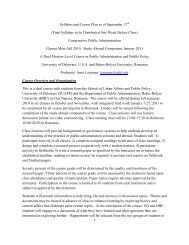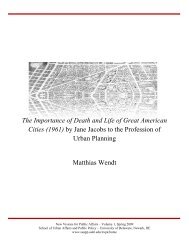New Visions for Public Affairs Volume 1 - School of Public Policy ...
New Visions for Public Affairs Volume 1 - School of Public Policy ...
New Visions for Public Affairs Volume 1 - School of Public Policy ...
Create successful ePaper yourself
Turn your PDF publications into a flip-book with our unique Google optimized e-Paper software.
Wendt, Matthias Death and Life by Jane Jacobs 2<br />
motherland further swelled the minority population <strong>of</strong><br />
some cities such as <strong>New</strong> York City.<br />
The benefits <strong>for</strong> GIs returning from World War II<br />
included a mortgage subsidy program allowing them to<br />
acquire homes at very liberal terms. In addition, the<br />
Federal Housing Administration provided mortgage<br />
insurance that minimized risks <strong>for</strong> home builders,<br />
banks, savings and loan associations and insurance<br />
companies. These federal programs restricting<br />
mortgages to new, single-family detached houses<br />
enticed both developers to construct single-family<br />
homes on the fringes <strong>of</strong> the metropolitan areas and<br />
young families to buy them. As a result, federal policy<br />
accelerated the downward spiral <strong>of</strong> American cities<br />
during the 1950s (Fox, 1986). In the central cities,<br />
landlords had no stimulus to renovate their residential<br />
properties, nor did private developers have motivation<br />
to build new rental housing. While the land values in<br />
the suburbs were booming, downtowns were decaying<br />
more and more as <strong>for</strong>mer city dwellers began to shop in<br />
the new enclosed malls that were developed in the<br />
brand-new suburbs. <strong>Public</strong> transportation systems<br />
continued to deteriorate as more people were driving<br />
automobiles and federal funds had been cut since the<br />
Depression.<br />
Between 1950 and 1960, all the older American cities<br />
lost inhabitants. The decrease in population hollowed<br />
out the urban cores and led to what planners call the<br />
“hole in the donut.” Boston, <strong>for</strong> example, lost 13<br />
percent <strong>of</strong> its population while its suburbs grew by 17<br />
percent. <strong>New</strong> York and Chicago lost less than 2<br />
percent, but their suburbs grew rapidly by over 70<br />
percent. Simultaneously, the industrial base <strong>of</strong> the cities<br />
shrunk. Between 1947 and 1967, the sixteen largest<br />
central cities lost on average 34,000 manufacturing<br />
jobs, while their suburbs gained an average <strong>of</strong> 87,000<br />
jobs. Following the people and jobs, merchants<br />
abandoned Main Streets <strong>for</strong> strip locations along<br />
highways or large shopping centers. Suburbia also<br />
became increasingly enticing <strong>for</strong> firms relocating their<br />
<strong>of</strong>fice uses, since the suburban <strong>of</strong>fice parks reduced the<br />
commuting time <strong>of</strong> their employees. In addition, the<br />
most rapidly growing industries, such as electronics,<br />
pharmaceuticals and aeronautics, were established in<br />
the suburban hinterland, leaving declining sectors,<br />
namely iron and steel manufacturing, textiles and<br />
automobiles, to the old central cities (Ruchelman,<br />
2004).<br />
Government did not completely neglect the cities. In<br />
keeping with the post-war propensity to think and act<br />
big, Congress passed the Federal Housing Act, which<br />
allotted great sums to build public housing <strong>for</strong> the urban<br />
poor. The Housing Act ushered in an era <strong>of</strong> master<br />
plans. All across the U.S., the “federal bulldozer” was<br />
pulling down entire blocks in areas which planners<br />
defined as “blighted” and were then rebuilt with huge<br />
high-rises. At the same time, municipalities were<br />
drawing up large-scale master plans to revitalize<br />
decaying downtowns with new civic centers. City<br />
<strong>of</strong>ficials and planners across the country<br />
enthusiastically celebrated public housing as the cure<br />
<strong>for</strong> all <strong>of</strong> the cities’ social ills.<br />
<strong>New</strong> <strong>Visions</strong> <strong>for</strong> <strong>Public</strong> <strong>Affairs</strong> – <strong>Volume</strong> 1, Spring 2009<br />
<strong>School</strong> <strong>of</strong> Urban <strong>Affairs</strong> and <strong>Public</strong> <strong>Policy</strong> – University <strong>of</strong> Delaware, <strong>New</strong>ark, DE<br />
www.suapp.udel.edu/nvpa/home







